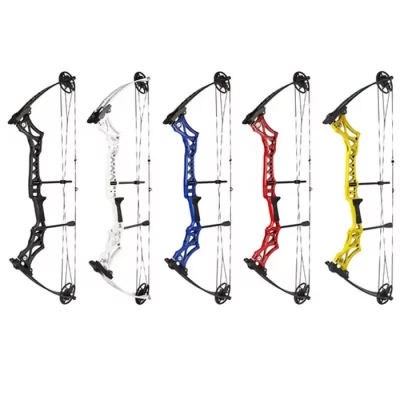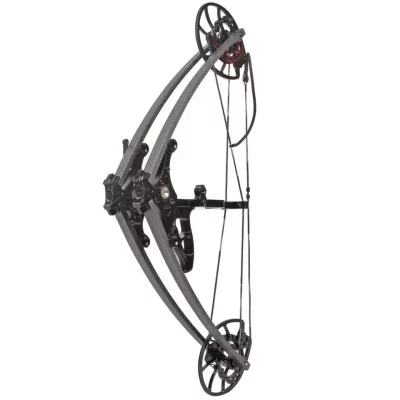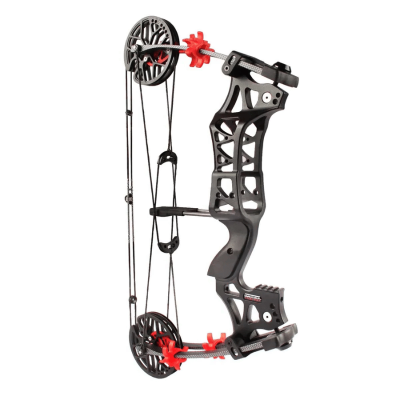You surely care to learn everything you want to know about how to shoot a compound bow, whether you are planning to buy one soon, or just curious about the subject. Well, I can help you. In this post, I will present to you the basics of how to shoot a compound bow, including guidance on how to choose the right bow and arrow, aim, draw and release it.
Properly Position Your Body
Proper bow shooting technique is the most important part of archery. Here are some tips to help you shoot a compound bow properly and accurately.
1. Grip the bow firmly with your dominant hand, then place your non-dominant hand on top of it. The index fingers should be aligned with each other, but not touching.
2. Slightly bend your knees so that when you draw back on the bowstring, your draw arm is about level with your shoulders; this will help prevent injury later on if you’re aiming for longer distances (more than 20 yards).
3. Make sure both feet are firmly planted on the ground, about shoulder width apart. Your toes should be slightly turned outwards (a natural positioning for most people).
4. Place your bow hand under the handle of the bow and place the tip of your arrow against the string below where it attaches to the bow handle. Use your thumb and index finger to pull back on the string until you reach full draw (the point when you cannot pull any further without releasing).
5. While holding onto both sides of the bow with one hand, use your other hand to pull back on the arrow’s fletching (feathers) so that they are facing upwards towards the sky.
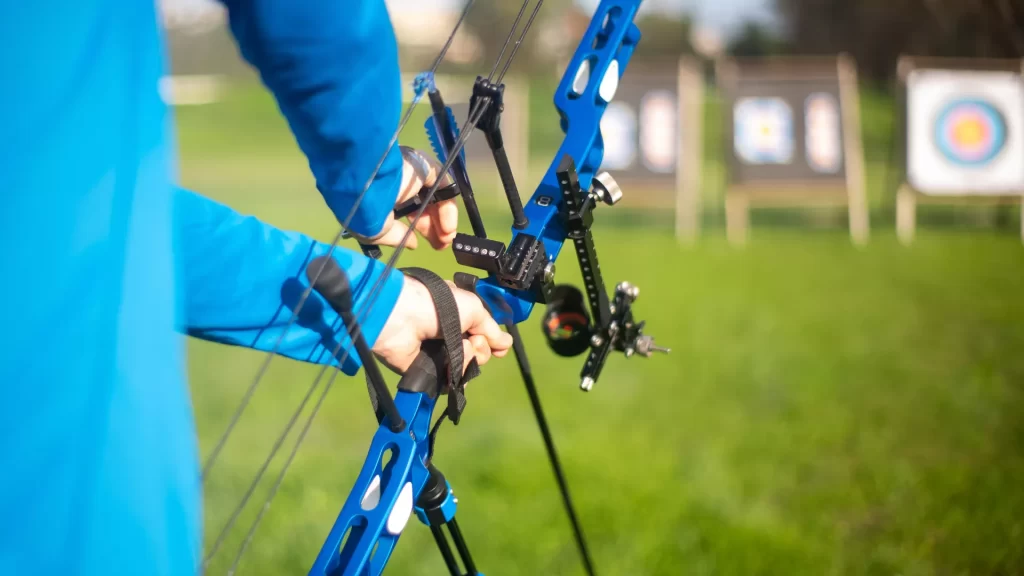
Grip the Bow With Your Dominant Hand
The way you grip the bow will vary based on whether it’s a compound bow or a recurve. Compound bows are easier to handle, but they have more moving parts, making them harder to master. Recurve bows are less complicated, but they can be difficult to shoot accurately if they’re not set up properly. Regardless of your choice, all archers should use their dominant hand when gripping the bowstring.
If you’re right-handed, place your left hand on top of your right and wrap it around the back of the bow. If you’re left-handed, place your right hand on top and cross it over your left as if shaking hands with someone behind you (keeping in mind that shooting a bow is not nearly as fun as shaking hands).
The reason for this is simple: Your dominant hand is stronger than your non-dominant one. You want to put all of that strength into pulling back on that string so you can send an arrow flying through the air with deadly accuracy and power!
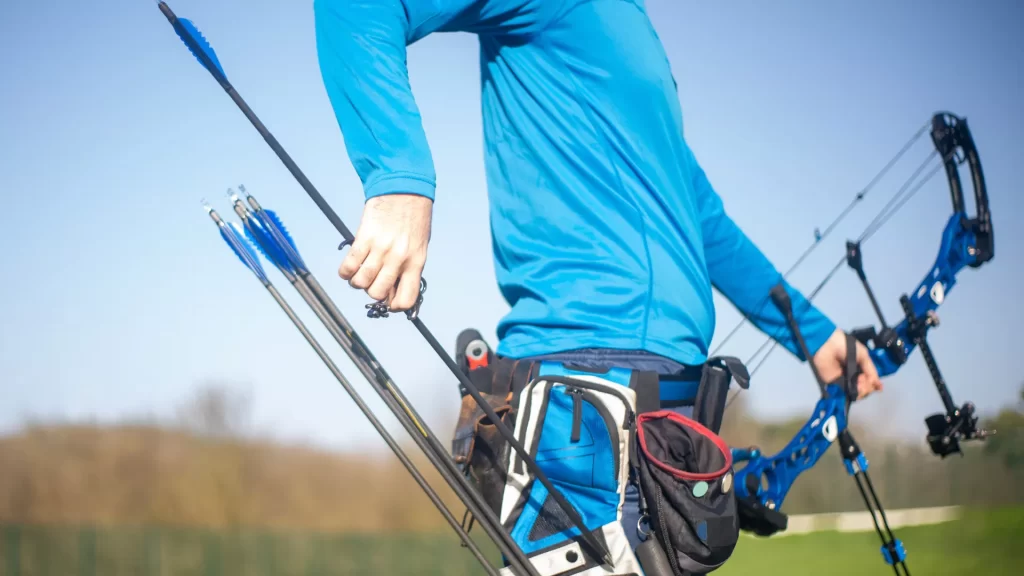
Nock Your Arrow
A compound bow is a complex piece of equipment. It takes many years to master and even more practice before you can become a good archer.
The first step in shooting a compound bow is to nock your arrow. Nocking the arrow means putting it in the correct position on the bowstring so that it will shoot properly. The arrow should be placed carefully on the string so that it is facing down at an angle toward the target and not sideways or backwards. When you draw back your bow, the arrow should be in place so that it flies straight toward your target once you release it.
The best way to nock an arrow is to use a nocking point. A nocking point is a small piece of metal or plastic attached to both ends of your bowstring and placed where they meet at the center of your bow’s riser – just below where you rest your fingers when drawing back an arrow (see Figure 2). There are several different types of nocking points available for purchase, including one-piece and two-piece models that snap onto your bowstring with ease.
Draw Back the String
The Draw Back the String technique is a way to shoot your compound bow. This is the best method of shooting a bow, and it allows you to be more accurate. The Draw Back the String technique will also allow you to release your arrow at the same time every time so that you can get consistent results when shooting at targets or animals.
The Draw Back the String technique is also known as “back tension.” It requires that you pull back on your string with two fingers, which is what causes back tension. This takes some practice, but once you get used to it, it can become second nature.
You should use both of your thumbs when using this method of shooting a compound bow. You should put them on either side of the arrow and then pull back on it until there’s enough tension in the string for you to take aim and shoot.
The main purpose behind this method is to increase accuracy by pulling back on the string with both hands instead of just one hand as some other methods require. By using two hands, you’re able to gain more control over how much force goes into each shot, which helps ensure that your arrows will always hit their mark (as long as they’re aimed correctly).
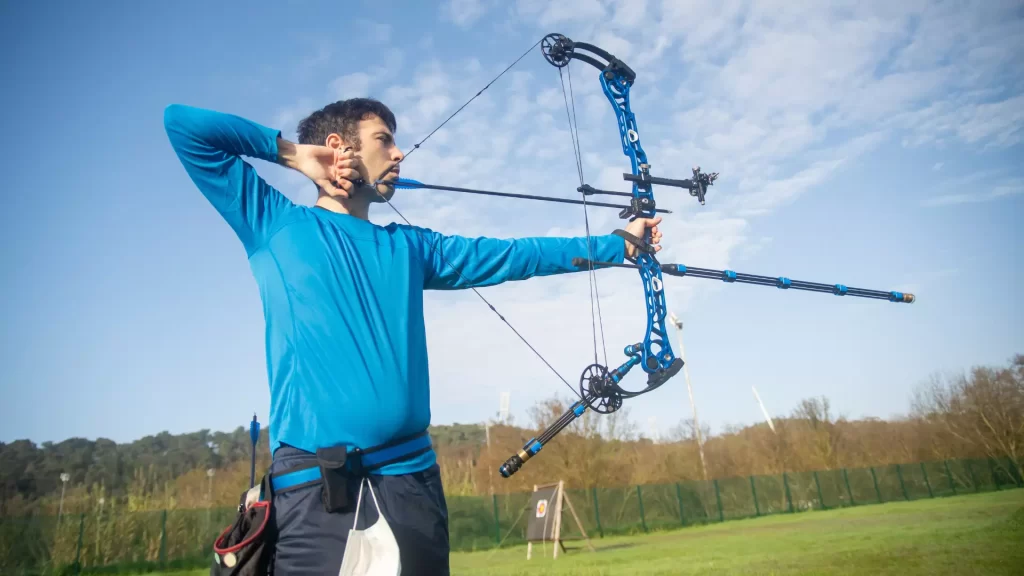
Anchor the String at Your Face
Before you can shoot a compound bow, you must first learn how to anchor the string. The anchor point is where you place your hand on the riser when shooting. It is important to have a consistent anchor point for each shot so that you can be comfortable and confident in your form every time you shoot.
The most common way to achieve this is by using a release aid. This device attaches between your wrist and the string and serves as an anchor point for every shot. You should practice using it until you feel completely comfortable with your form and can consistently hit bullseyes at 20 yards or further.
If you don’t want to use a release aid, try placing your index finger on one side of your nose and locking it there with some tension in your arm muscles. Do not allow any other part of your hand or fingers to touch anything other than your nose or face as this will throw off accuracy and cause inconsistency in your shots.
Check for Good Form
Compound bows have several unique characteristics. First, they’re able to reduce the draw weight as you draw back the string. This is different from traditional bows where you must pull back with the same amount of force at all times.
In addition, compound bows use a pulley system to make it easier to pull back the string. This pulley system also allows archers to use more poundage than they would be able to with a traditional bow. The pulley system on a compound bow can be adjusted based on the height and strength of the archer.
Compound bows are also designed with an adjustable sight that allows shooters to see where their arrow will hit when they release it from their bowstring. Traditional bows don’t have sights because there’s no need for them since every shot must be consistent and precise without any variation in distance or angle between shots.
Focus on the Target
Shooting a compound bow is an activity that requires a lot of concentration. If you have never done it before, you may find that it is difficult to concentrate on the target while pulling back on the string. This is why it is important to practice as much as possible with your bow so that you can get used to it and become more familiar with how it works.
You should also make sure that you are using the right kind of target when practicing shooting a compound bow. Shooting at a paper target will not give you much feedback about whether or not your shot was successful. You need something that will tell you if your arrow hit its mark or not, such as a foam target or even a cardboard target with holes cut out of it in various places.
The safest way to shoot a compound bow is by first drawing back on the string gently and then releasing it slowly and smoothly. This will prevent any accidents from happening because if something goes wrong during this process, there will be plenty of time for the shooter to stop pulling back on the string before releasing it completely.
Release the String, Letting the Bow Do The Work
Shooting a compound bow can be a challenging experience, but with the right technique, it can be fun and rewarding.
Compound bows are different than longbows or recurve bows. With a compound bow, you don’t pull back the string to shoot an arrow. Instead, you pull back the string to cock the bow and then release it to shoot. This is called “letting the bow do the work.”
When shooting a compound bow for the first time, it’s important to learn about how to hold your draw hand and other safety procedures before attempting to shoot your first arrow.
Buy a very affordable compound bow
-
Junxing Archery M108 Compound BowProduct on sale$205.99
-
JUNXING 109A Compound BowProduct on sale$269.99
-
JUNXING 109E Compound BowProduct on sale$369.00
How To Shoot A Compound Bow FAQ
how to sight in a compound bow?
The process of sight-in involves testing and adjusting your bow to make sure it is shooting an arrow consistently and accurately. This process can be done anywhere, but the most common locations are at a range or in a field.
Sighting in a compound bow is not difficult, but it does require some practice and patience. If you need help learning how to sight in a compound bow, here are some tips on how to sight in your bow:
1) Remove all arrows from the quiver and lay them on the ground in front of you so that you can see them as you shoot. This will help you stay focused on what you’re doing instead of looking for arrows every time you shoot.
2) Clear any obstructions from around the target area such as brush, trees and rocks so that there’s no chance of an arrow hitting them during the sighting in process.
3) Set up your target at least 20 yards away from where you will be standing while sighting in the bow. Make sure there are no other people nearby who may obstruct your view or distract you while aiming at the target or during subsequent shots after making adjustments to your sight settings or arrows being used (different arrow weight s and spine).
4) Make sure you have plenty of time set aside to do the sighting in process. You don’t want to rush through this step or feel rushed by other people who may be waiting for your turn at the range or hunting area.
5) Take five arrows with different weight points on them and shoot them from your bow at the target in order to determine which weight point gives you the most accurate shot placement.
how to restring compound bow?
The first thing you need to do is remove the old string. To do this, make sure you have a quality stringing tool (or at least one that is compatible with your bow). Then, remove both ends of the string from the bow and spool.
Next, place a new stringer on the cams and hook it over the bolt with a hook-like part. Then, pull down on the new string until it makes contact with your bow limbs.
Once this is done, you will want to push down on the cam stack so that it locks into place. This will ensure that your new string does not come off during use.
Now, you will want to start wrapping the new string around itself by turning your crank in a clockwise direction until it becomes tight enough for you to pull back on it and test out how much force it can take before breaking or becoming loose again.
If your new string breaks when pulling back on it hard enough to make sure it has enough tension, then you should repeat this process until you get one that works well enough for normal usage without breaking under pressure.
how to adjust draw length on a compound bow?
The draw length is the distance from the bowstring to the arrow nock, measured at full draw. The correct draw length is essential for accuracy, safety and comfort when shooting a compound bow.
If your bow has an adjustable draw length, you can shorten or lengthen it by moving the limbs in or out of their pockets on the riser (the frame of the bow).
The following instructions describe how to adjust a compound bow’s draw length.
1.Make sure the bowstring is loose enough to move freely in its track. Remove any knots or twists in the string by running your fingers along its entire length.
2.Adjust your sight pin so it’s level with the center of your sight window and centered on the top edge of your peep sight window (if one is present). This helps ensure that you’re drawing equally on both sides of your riser when adjusting limb placement.
3.Loosen all limb bolts by turning them counterclockwise with a wrench until they stop turning easily — but not so much that they fall out! Then tighten them again until they’re snug against their respective limb pockets; don’t overtighten them!
how to adjust compound bow draw weight?
Adjusting your draw length is the first step in adjusting your bow’s draw weight. Draw length is the distance from the back of your ear to where you want your arrow to rest on your stabilizer after you release it.
Adjusting Your Draw Length: Use a bowstring and arrow to determine what draw length is best for you.
1. Tie an eye loop in the middle of a string, then slide that loop over one end of an arrow (the nock).
2. Place the arrow on the string so that it rests at the same spot where you want it to rest after shooting, which is usually just in front of or slightly behind the back of your ear.
3. Pull back on the string until it touches your cheekbone, then release it without moving any part of your body except for your fingers and hand holding the string. The point where the arrow falls off should be exactly where you want it to fall off when shooting at game in hunting situations. If not, adjust accordingly until this happens .
4. Once you have mastered the process of shooting, it is time to start hunting. The best way to do this is by practicing with a friend who has experience in hunting and can help you learn how to shoot properly.
how to restring a compound bow?
To restring a compound bow, you will need to remove the cams. Most compound bows have an adjustment system that allows you to release the cams with ease. You will then be able to remove them from the bow and replace them with new ones.
The first thing that you need to do is place your hand on the bowstring and lift it up until it is parallel with the arrow rest. This will make it easier for you to pull off the old strings and put on new ones.
Next, unscrew the limb bolts at both ends of the riser and remove them from the limb pockets. Take out the old string by pulling on each end until it comes off completely. Make sure that you have removed all of the old string before putting on new ones as this can damage your bow if not done properly.
Now that all of the old strings are out, get ready to put in your new strings by making sure that they are smooth and not frayed or broken in any way whatsoever because this could cause problems when you are trying to shoot at targets later on down the line if they break or snap for some reason while shooting at targets!
how to tell if a compound bow is left or right handed?
Compound bows are used by both right- and left-handed people, but there are a few ways to tell if a bow is right or left handed.
The first thing you need to do is check the riser. This is the part of the bow that connects to your handgrip. Most compound bows have an arrow rest on one side of the riser and an arrow shelf on the other. The arrow rest will be on the opposite side from where your dominant hand rests on the grip. If you’re right handed, for example, your left hand will be resting on top of the grip, so look for an arrow rest on your right side (left side of bow).
If you’re left handed, this won’t apply to you because you shoot with your dominant hand anyway. The same goes for ambidextrous archers who shoot with their non-dominant hands.
Another way to tell if a compound bow is left or right handed is by looking at how it’s strung. A right-handed bow will have an “L” shape strung into it when you look down at it from above; a left-handed bow will have an upside down “L” shape strung into it when you look down at it from above. This can be a good way to tell if your bow is right or left handed, but it’s not the only way.
how to adjust compound bow sights?
Adjusting your bow sight is an easy way to increase your accuracy and improve your scores. Here’s how to do it.
Loosen the screws on the sight and adjust them up or down so that there is 0″ of string travel when you release an arrow. This means that there should be no movement of the bowstring when you shoot an arrow and it hits the target.
Hold the bow horizontally with one hand, then turn the screw on low-mount sights clockwise to raise the point of impact (POI), or counterclockwise to lower it. The opposite direction applies for high-mount sights — turn clockwise to lower POI and counterclockwise to raise it.
what is brace height on a compound bow?
Brace height is the distance from the string to a point on the riser, usually at or near the midpoint of the grip. This is one of the most important factors in determining how much power you can get out of your bow.
The longer your brace height, the more energy you have stored in your limbs when they are relaxed at full draw. The shorter it is, the less energy you have stored and thus less power you have available to shoot with.
Brace height also affects arrow flight since it affects how much time it takes for an arrow to leave the bow and reach its peak velocity. A longer brace height means there will be less time between when the string comes off your fingers and when it begins pushing down on your forearm and shoulder muscles.
So, if you have been wanting to learn how to shoot a compound bow, or if you are just curious on how it is done, then this article will help you out. Hopefully this article has answered your questions and next time you are on the archery range, you will be shooting like an expert.


